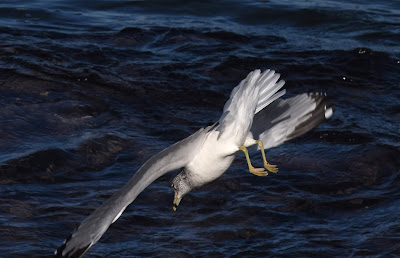A series on birds at Halibut Point with diverse
adaptations
to finding food below the water surface:
Dabblers, Plungers, Divers, and Pursuers.
 |
Belted Kingfisher
scanning
|
 |
Kingfisher rising
|
 |
Ring-billed Gull
hovering
|
When small fish appear near the surface this species is capable of going after them.
Migrating juvenile fish driven into the shallows by predators make a perfect opportunity for a moderate plunger.
Minnows schooling near the quarry surface are fair game for Ring-bills. Great Black-backed and Herring Gulls lack the quickness for this technique.
 |
Northern Gannet
|
When striking they tuck into an aerodynamic posture for speed and fine ballistic steering. Just before hitting the surface they tighten into an arrow to penetrate the water to the fish's depth.
Their foreparts are reinforced to withstand impact. Unlike gulls, the design of their legs and feet enables them to chase fish under water.
After a successful dive a gannet may have to swallow his prey quickly at the surface before a gull can arrive to do what gulls do best. Even-handed biologists call the gull's way of making a living kleptoparasitism, a fancy term for stealing, but less invasive than lodging inside and digesting a host's internal organs.
Then the honest predator lifts off the water to fly in search of another meal.







No comments:
Post a Comment